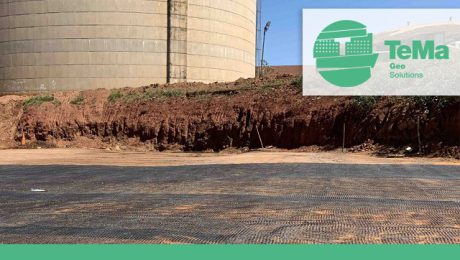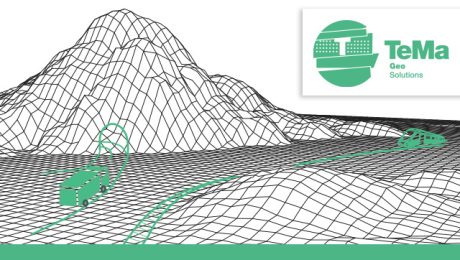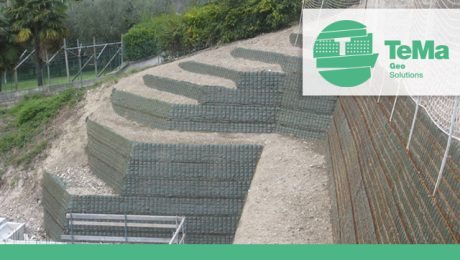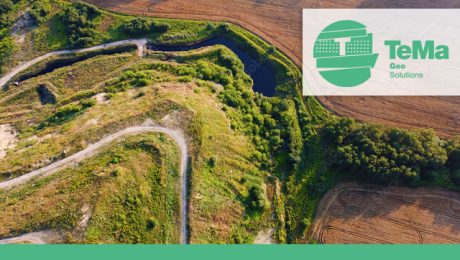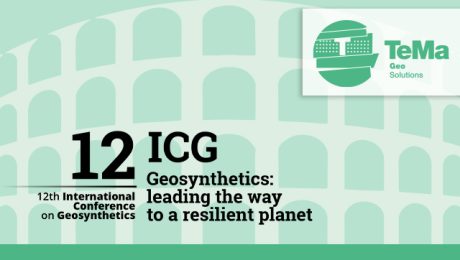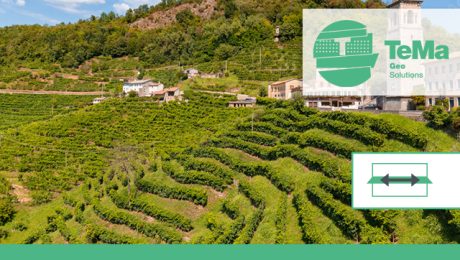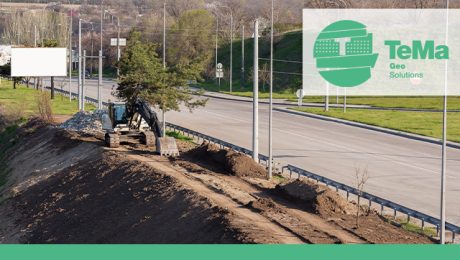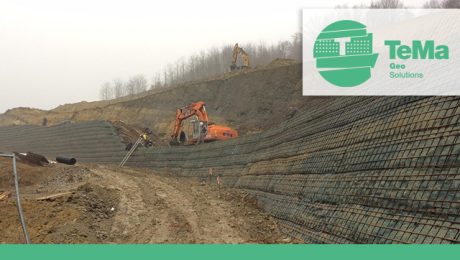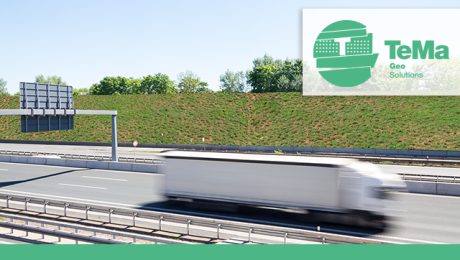Ground reinforcement and stabilization with TeMa geogrids as part of foundation groundworks
Foundation base reinforcement for the construction of rigid reinforced concrete structures on unstable areas: a challenge for engineers across the globe. Sure enough, designers find themselves having to contend with the risk of differential foundation settlement, which can result in cracks in the structure. This means any unsound material in the area often has to be dug out and carted off site, while the layers have to be built up again using materials brought in specially, which can sometimes be expensive. The foundation bed must provide the required bearing capacity and, above all, must eliminate the risk of differential settlement.
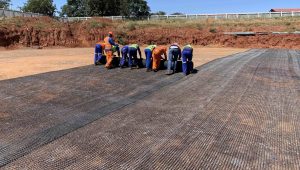
The Katlehong job, in South Africa, was a major project for TeMa in a highly critical construction context, given that it involved building a municipal water reservoir in the shape of a 200 thousand hectolitre tank.
With the introduction of a number of geosynthetic products in place of conventional building materials, the costs came in significantly lower than initially projected and structural efficiency was improved considerably across such a large project, promising to deliver a long service life.
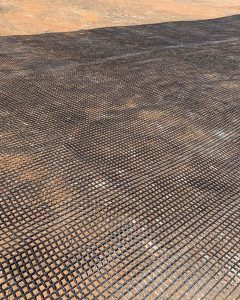
The TeMa solution in cases like these: laying X-Grid PET-C-0 100/100 Biax — a biaxial stabilization geogrid woven from high-strength polyester, with a protective polymer coating — over the whole bed in alternating layers with fill material between. With each new layer, the geogrid has to be placed with the appropriate orientation to ensure the structure’s foundation will provide the required overall stability and bearing capacity, thus allowing for and negating the negative effects of any differential settlement.
The use of TeMa Geo geogrids allows for space to be incorporated into the design to accommodate the underground services associated with the structure being built, while providing the designer with significant advantages, compared to the use of conventional natural materials, including ease of installation and shorter construction timeframes.
TeMa Geo Solutions: geotechnical solutions
The TeMa Geo Solutions division has developed considerable experience in geotechnical applications and developed technologies and products, thereby ensuring that designers can meet increasingly strict regulations concerning the environment and the landscape.
These applications are for the protection, maintenance, retention, reinforcement and drainage in the field of major environmental projects, involving products that provide innovative efficient and long-lasting solutions.
We are aware that a kind of public resistance to sustainability announcements has already begun. We are therefore interested in helping companies that are taking appropriate action to protect the environment. This is not only to ensure that they can better comply with regulations but also, and above all, to increase the effectiveness and credibility of their work.
TeMa Geo solutions in applications
The areas of expertise of TeMa Geo Solutions include:
- football fields
- landfills and contaminated sites
- tunnels
- reinforced soil retaining structures
- dry slopes
- grassy road and railway embankments
- roads
- drainage ditches
- horse training and racing tracks.
Products and functions: a range starting with geosynthetics
Geogrids are structural elements used to reinforce soils in the construction of retaining walls, block retaining walls, reinforced soil retaining structures, landfills and contaminated sites. The open mesh structure allows the reinforcement geogrids to develop ‘passive’ resistance at the transverse ribs, thus effectively increasing their inherent stabilising effect and enabling the system to withstand significant levels of stress.
The TeMa Geo Solutions range includes uniaxial or biaxial X-Grid geogrids made of fibreglass, polyester or PET coated with a polymer layer, coupled, or not, with a nonwoven geotextile, to be chosen to suit the project.
Offering products such as bentonite geocomposites, drainage geocomposites, facings, erosion control mats and essential accessories, the TeMa Geo Solutions range fulfils various functions for the retention anddrainage of rainwater and groundwater.
The TeMa Geo world offers its long-standing (since 1993) expertise and experience in the polymer-based product category (geosynthetics). Over the years, research at its in-house labs has enabled the development of solutions that integrate with the environment in a more specific sense, such as biodegradable erosion control mats, and in a broader sense, such as geomats and studded membranes.
TeMa also offers cutting-edge geotechnical solutions for vineyards
This is not surprising, as the TeMa Geo headquarters are situated on the eastern edge of the Prosecco hills, a UNESCO World Heritage Site. The company therefore has made its experience available to preserve and protect the viticultural landscape with its products for erosion control, reinforcement and ground drainage in an environment subject to the passage of agricultural vehicles. Click here to download the specific catalogue.
System for reinforced soil retaining structures
T-System is the system from TeMa Geo Solutions that includes various components for strengthening, surface erosion control, drainage and retaining used in the construction of reinforced soil retaining structures: innovation that we’ve been exploring here at TeMa since our inception 30 years ago, and that is now one of our hallmarks. Let’s take a more detailed look below.
Components for strengthening
Designed for strengthening, the knitted X-Grid PET C geogrids are made from high-strength polyester yarn, with a protective polymer coating. They deliver tensile strength in the 20 kN/m to 800 kN/m range.
Components for erosion control
They protect the face of the structure from erosive agents, like wind and driving rain, until the vegetation has had time to establish. TeMa Geo Solutions offers natural solutions made from cellulose fibres, like Ecovermat, or jute fibres, like Ecovernet, as well as synthetic solutions made from monofilaments (K-Mat F), polypropylene (K-Mat FA) or fibreglass (K-Mat FG Green).
Components for drainage
Drainage geocomposites like Q-Drain are used to address the problem of water seeping into the backfill.
Components for retaining
We have a line of facings made from electrically welded wire mesh — with inclinations ranging from 65° to 80° — to ensure the exposed face is straight.
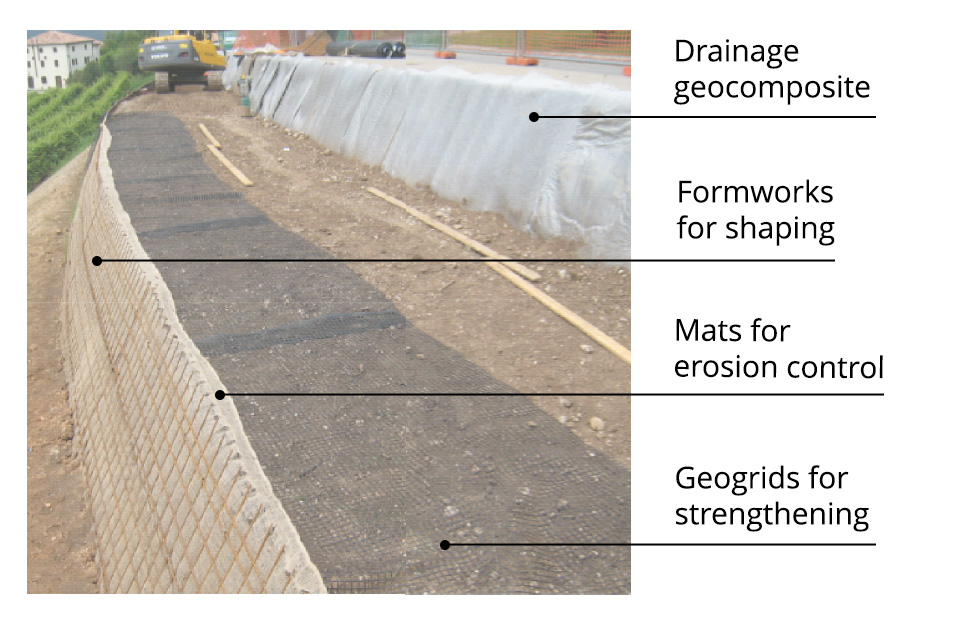
Practical tips
On site
System components must be stored well away from machinery, and suitably protected from dust or residues from work on site.
To avoid excessive overlaps and waste, the X-Grid geogrids must be cut to size using a suitable metal stand with metal trestles supporting a circular rod to be inserted inside the roll.
Erosion control components — whether biodegradable or synthetic — must be stored in a dry place and not in direct contact with the natural ground, so as to avoid laying problems later on.
Metal formwork must be stored well away from areas where machinery is operating, and carried in only when it is time to install.
During assembly, it is best to apply U-shaped strips of rubber or metal so that the geogrids can be wrapped correctly over the formwork without getting caught on the top of the bars. (see photo)
Special instructions
We advise against backfilling with silty and clayey material; at the very least, only use this kind of material after mixing it with aggregate.
The full range of system components comes with instructions on the relevant procedures to be followed. Contact us, we’ll be happy to provide case studies and full information.
Safety first: and that applies to landfills, too
TeMa Geo Solutions’ thirty years of experience extends to the field of controlled landfills and contaminated sites, with products specially designed for each function to ensure the site is safe, and with investment-conscious solutions, as well as a focus on ensuring peak performance.
Safe landfills legislation
In Italy, regulation around the controlled disposal of waste dates back as far as 1982, later supplemented by the European directive and updated in 2020 by Italian legislation (D.Lgs no.121).
This legislation covers all aspects of the disposal cycle, from landfill classification to the type of waste, as well as criteria for the construction and operation of the facilities, with a strong environmental focus. In this regard, TeMa has come up with built-up systems and materials that fulfil the required functions and comply with the relevant legislation.
The main functions to make safe a controlled landfill
Making safe a landfill facility entails fulfilling a number of functions:
![]() Barrier
Barrier
Walls and floor must be isolated to protect groundwater and soil from leachate and biogases resulting from decomposition processes. To ensure sufficient watertightness, legislation requires the use of at least 0.5 m of clay or, drawing on the principle of hydraulic equivalence, synthetic products: sodium bentonite composites like Barrier Bento — which contains up to 5 kg of bentonite/sqm sandwiched between two geotextiles — provide an impermeable layer, acting as a barrier between soil and waste.
![]() Reinforcement
Reinforcement
One of the major issues to be addressed when designing landfills, especially the capping system, is stability, which can be achieved by leveraging the compressive strength of the soil combined with the tensile strength of geosynthetics. Reinforcement solutions provided by TeMa range from PET-series geogrids to geomats laminated with geogrids.
![]() Drainage
Drainage
For liquid and gas capture, legislation calls for the use of 50 cm of aggregate, which nonetheless can come with its own stability issues, especially on steeper slopes. With the use of drainage geocomposites, the relevant built-up system can be pared back, while the number of vehicles required to carry materials can also be reduced. TeMa’s offering ranges from studded and micro-studded membranes to monofilaments laminated with nonwovens, and geonets with one or two nonwoven layers.
![]() Erosion control
Erosion control
The top layer of the soil is eroded by the action of the elements — especially by the type of unpredictable and extremely violent weather events we’ve witnessed in recent years — triggering alarming landslips, which can undermine a site’s hydrogeology. To prevent issues of this kind, it’s essential to encourage vegetation (which serves as a form of natural erosion control) and protect the soil while it takes root by using natural or synthetic mats from TeMa.
TeMa at the 12th International Conference on Geosynthetics.
We too will be at the 12th edition of the International Conference on Geosynthetics that will take place in Rome, at the Parco della Musica auditorium from 17 to 21 September 2023, and which will involve a full programme of meetings between professionals (further information about the events here).
Four days of training and information meetings on geosynthetics, exploring all sub-types: woven and non-woven geotextiles, geogrids, geonets, geomats, drainage and reinforcement geocomposites, and geomembranes.
Geosynthetics are becoming increasingly popular in applications and fulfil various functions (often combined). For example:
- Drainage – drainage geocomposites and geonets.
- Filtration and Separation – woven geotextiles and non-woven geotextiles.
- Reinforcement – woven geotextiles and geogrids.
- Protection of waterproofing – studded membranes with truncated conical or star-shaped studs.
- Erosion control – geonets, geomats, biotextiles.
- Mechanical protection – non-woven geotextiles, composite geotextiles.
- Special applications – various geosynthetics made to specific requirements.
The main topics discussed will cover various fields of application, including anti-seismic design to road and railway embankments, erosion control, filtration and drainage functions, as well as an analysis of case studies.
The world of research is continuously evolving and the scheduled meetings will provide an excellent opportunity for sharing experiences and recent technical developments with engineers, geologists, consultants, contractors and whoever is involved in research and using geosynthetics.
During the exhibition event visitors will be able to take part in technical conferences, the Giroud lecture, special lectures and short courses , as well as visit the exhibition hall to meet manufacturers.
TeMa has thirty years of experience in using geosynthetics
The international event, entitled ‘Leading the way to a resilient planet’, fully represents the reason why TeMa began to manufacture and experiment with geosynthetics from the mid-1990s onwards: to research the most suitable technologies and materials for use in the construction of buildings and geotechnical works.
We have been involved in continuous interaction, also due to an increased awareness of major environmental issues. This has enabled us to broaden our range of products and expand in 80 countries worldwide.
Today, our catalogue includes many products that meet specific requirements for landfills, tunnels, road embankments, river banks and reinforced earth structures, gradually increasing performance for surface erosion control, rainwater drainage, and the reinforcement of grassy slopes.
The geosynthetics sector is rapidly developing and we are making huge investments, especially in research, so as to supply our customers with the best solutions, also tailor-made, for their projects. We share the same ‘urgency’ as our partners to pursue our unwavering ideal of respecting the environment and the hydrogeological protection of the land.
We look forward to seeing you in Rome from 17 to 21 September 2023, at Stand 22.
Meanwhile, you can discover all the details about the event here.
Reinforcement of slopes and embankments
Slopes and embankments can be used as road or railway embankments, raised flood banks and floodplains, and even vineyards, especially in a territory such as Italy, one of the countries with the largest number of UNESCO World Heritage landscapes in the world.Many of those greened terraces are true reinforced earth structures, with their stability guaranteed by a well-tested construction technique.
Stability for slopes and embankments
Reinforced earth structures are retaining works that allow slopes and embankments to be supported, including steep slopes. They do not involve the use of concrete constructions, which would be more detrimental to the landscape.
The soil has a natural capacity for compressive strength. When combined with geosynthetic grids (which have excellent tensile strength), they create a stable system, as the features of the two components provide a high-performance composite.
The open mesh structure allows reinforcement geogrids to develop passive resistance along the transverse ribs, as well as creep resistance of the geosynthetic grid in relation to the soil. The TeMa Geo Solutions range includes X-Grid geogrids, available in a variety of models depending on the type of project.
How to position the geogrid in the layering of a terrain?
Each slope needs to be carefully and expertly engineered. However, in addition to the need to reinforce the raised earth structure with geogrids, it is essential to ensure surface erosion control using synthetic or natural erosion control mats and shaping with electro-welded wire mesh formwork.
The X-Grid geogrid must be applied to each ‘block’ of soil supported by the formwork, positioned between the backfill soil and the erosion control mat. An external wrap-around part, measuring no more than 150 cm, must be provided for the formwork system by installing formwork stiffening ribs approximately 30 cm apart.
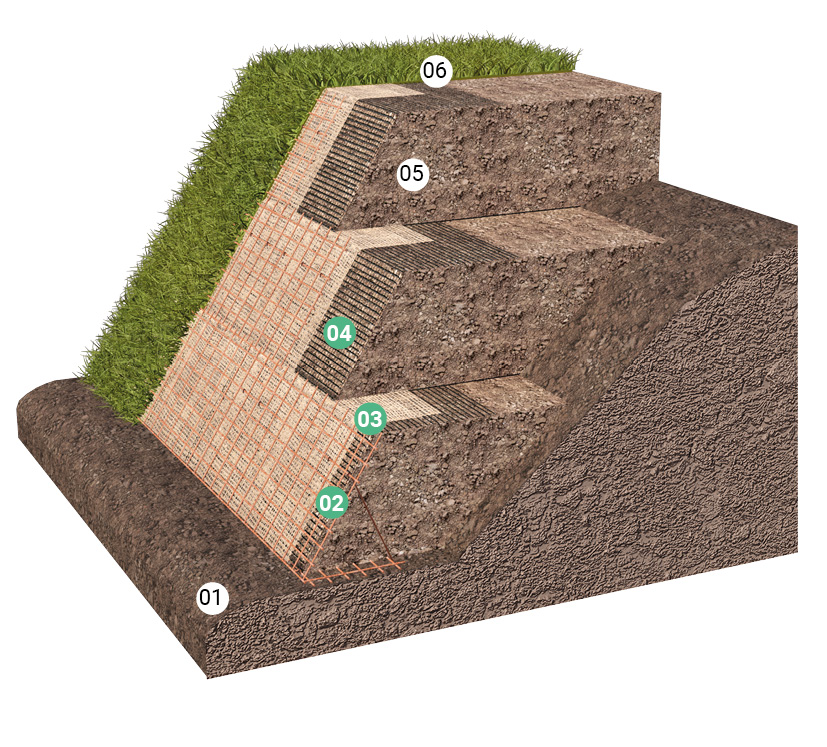
- Foundation soil
- Metal formwork
- Erosion control mat
- Geogrid
- Backfill soil
- Grassed surface
- Published in environmental, GEO, Geogrids, Reinforced earth structures
Technical considerations in building reinforced soil walls
Reinforced soil walls have proved highly popular in recent years and are produced wherever possible, taking the place of concrete-faced soil retaining wall systems.
Employed in a range of different environments, they bring significant advantages, both financial and environmental. Indeed, unlike concrete-faced soil retaining wall systems, they:
- are sustainable because they give a vegetated finish;
- are a great space-saving solution, with slopes as steep as 80° (compared to the 30-40° of natural soil embankments);
- result in less pollution given the smaller number of trucks required to carry construction materials;
- make use of the excavated earth for backfilling, provided it is compatible with stability standards, meaning no more material needs to be brought in;
- blend seamlessly with their surroundings once the slopes are grassed over, without becoming a blot on the landscape of our villages.
Whatever the case, before planning the work, there are a number of aspects and data to be taken into consideration.
Preliminary data needed
To start with, all essential technical information must be procured in order to be able to assess the feasibility of the project, such as:
- geological testing of the area on which the wall is planned to be built
- topographical surveys
- meaningful cross-sectional drawings showing the current condition
- geometry of the planned wall (face angle, height, division into tiers, slope on top)
- external loads applied to the structure (top loads in the event it needs to accommodate a car park or a road)
- what earthquake risk zone the area is in
- geotechnical properties (angle of shearing resistance, cohesion and density) of the earth behind the future wall, of the foundation soil, and of the backfill
- whether there are perched aquifers or seepage of a different nature.
At this point, the next step is to check design calculations using specific software.
Checking design calculations
Checking is performed to assess both internal and external stability. The following tests are carried out in the former case:
- reinforcement strength test, which assesses possible failure mechanisms and determines the spacing, length and tensile strength of the geosynthetics due to be laid
- pull-out test to check that the reinforcement applied does not break or slide out
- direct sliding test, to ensure there is no translational movement across the installation planes
- wrap-around test, to ensure that the length wrapped around the top of each individual layer is stable.
The checks to be carried out during the project’s execution to assess external stability consist in sliding, overturning, bearing capacity and global failure analysis.
Do you want to chat with one of our experts to find the solution that best suits your requirements?
We have 30 years of experience in the industry and can give you access to materials and solutions offering specific performance. Contact us!
Do you want to learn more about the full TeMa Geo Solutions product range for reinforced earth structures? Click here.
Cycle and pedestrian paths: solutions to make them safer and more attractive.
Longer days, milder afternoons, a great desire to spend time outdoors and perhaps get some physical exercise, but also go to work and school or visit a friend… These are all good reasons for using, when available, cycle and pedestrian paths, possibly far from urban traffic.
The advantages of sustainable mobility
We are increasingly talking about environmental sustainability and the physical and psychological benefits of physical exercise:
- Less air and noise pollution caused by traffic.
- Reduced transport costs.
- Greater freedom of movement.
- Enhanced green areas in cities.
- Better quality of life by doing a bit of sport on a daily basis.
TeMa Geo Solutions for safety and urban benefits
‘Unequipped’ roads can be hazardous for those who choose to get around by bicycle: for this and environmental reasons, cycle and pedestrian paths are the ideal solution, as they are increasingly becoming part of local government mobility plans.
TeMa Geo Solutions offers all its experience by combining reinforced earth structures and their feature of being green, with cycle and pedestrian paths.
An embankment can be made or a road widened with its sides sloping at 65°/70° using the T-System (consisting of formworks, X-Grid PET geogrids and K-Mat FG Green erosion control mats as facing), thereby making the path safe and allowing a slope to turn green again. Making a slope green again provides a natural erosion control function: to encourage it, TeMa Geo Solutions recommends installing natural or synthetic mats. To make the structure stable, the T-System for reinforced soils adopted by TeMa involves using X-Grid PET geogrids.
Reinforced earth structures and drainage
For the extension works at the Serravalle Retail Park shopping centre in the Piedmont region, we helped the company choose the solutions to implement and assisted with verifications.
The area covering about 2,000 sqm required some intervention work regarding reinforced earth structures and drainage. In particular, we undertook the preliminary work for extension works dating back to 2016.
To the south-west of the building, the soil was secured and then surfaces were replanted with greenery.
Let’s see how this was done in more detail.
Type of intervention
In order to make the slope in front of the complex secure, the intervention work involved constructing reinforced earth structures in several banks, more specifically 3 modules of 6 m in height each.
In addition, to manage the water coming from the hydro-geographic basin situated upstream of the area, specific surface drainage works were carried out.
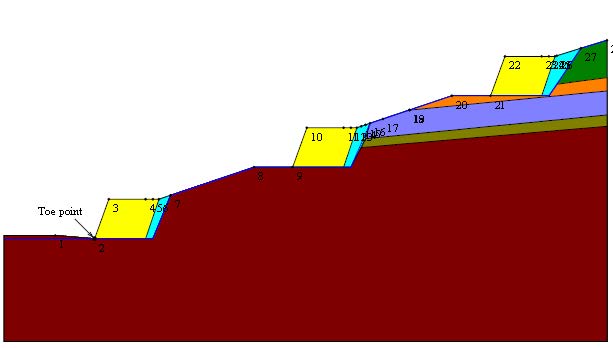
The solution from TeMa Geo Solutions
For the reinforced earth structure, 3 modules were constructed with anchorage lengths of 7 m and a strength of 110 kN/m provided by X-Grid PET PC 110 geogrids.
As for drainage, instead, a Membrana Nera Geo was used, the 8 mm HDPE studded membrane bonded to a filter nonwoven geotextile with a PE slotted tube at the base.
The drainage system was also installed at the horizontal contact points of each berm to prevent future water seepage into the reinforced earth structure.
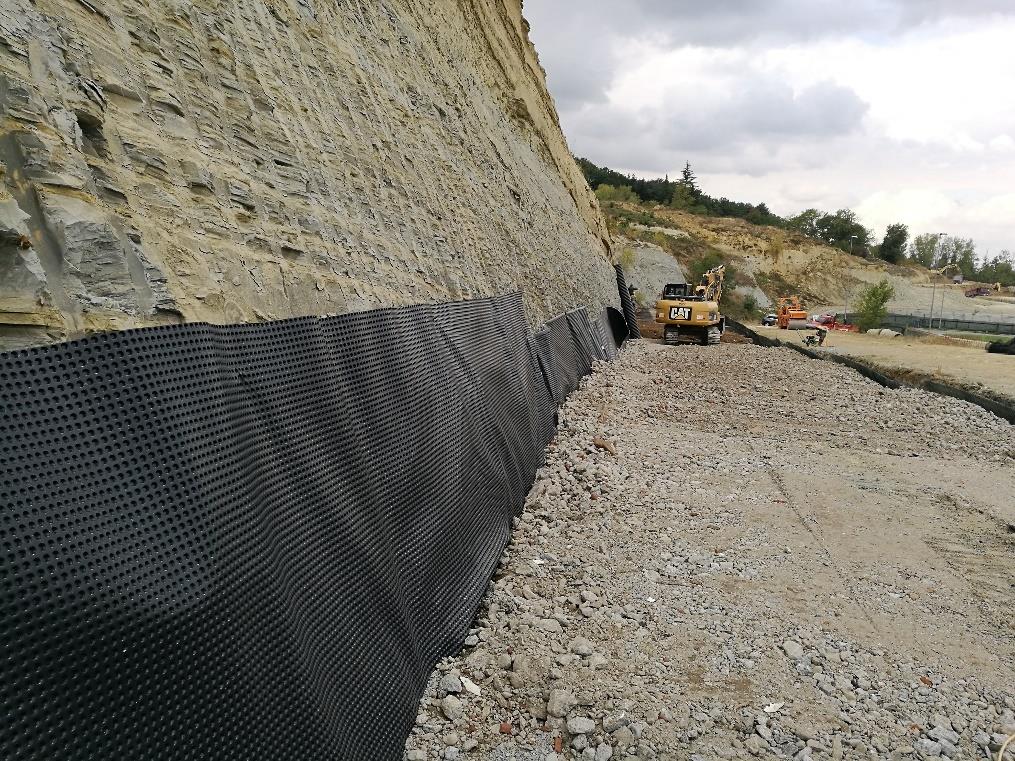
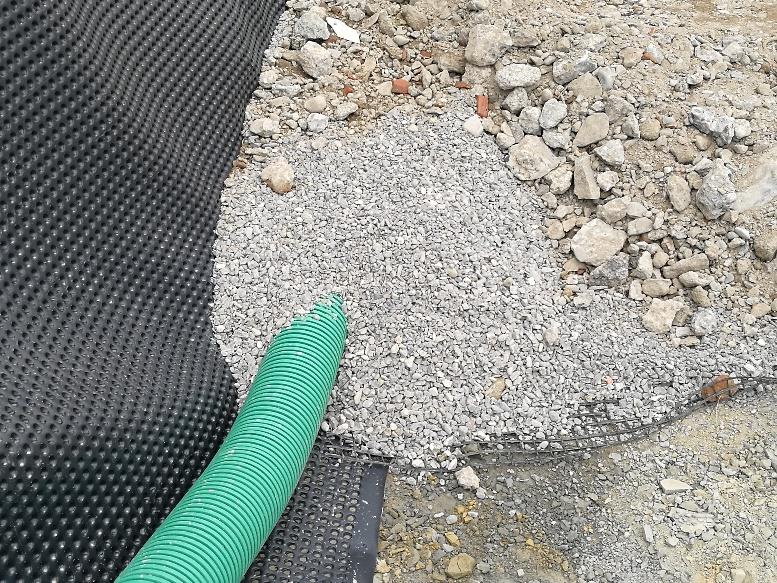
Reinforced earth structures as noise barriers
Hearing the noise of traffic outside your window all day long is irritating and distracting and, in the long term, also harmful to your health.
This is why the WHO and a number of laws govern the use of noise remediation systems in cities: the Framework Law no. 447 of 1995 for Italy and the European Directive on Environmental Noise no. 49/2022. If the cause of the noise cannot be addressed, the solution is to install protective barriers. Various kinds can be used, but in this case we focus on reinforced earth structures that require specific measures, which we discuss here.
For example, the Pedemontana Veneta is a new toll motorway in Italy: nearly 100 km long. Almost entirely in operation in the north-east of the Veneto region, the main route of this motorway runs through a deep trench in order to minimise the ‘territorial’ and environmental impact on the surrounding area. This means that long sloping areas of reinforced earth can be found along the sides of the motorway, with rows of trees and hedges for 58.61 km and green areas covering 1,333,410 square metres of hedgerows, groves, grassy slopes and tree-lined meadows.
A focus on noise with much regard for the landscape.
What do reinforced earth noise barriers consist of?
For this type of embankment with its typical trapezoidal shape, earth is used that will be covered by vegetation over time. Geosynthetic reinforcements and geogrids are added to support the earth, which already has good compressive strength. These are inserted horizontally into the ground and develop friction and tension that stabilise the structure, increasing its resistance to stress.
The TeMa Geo Solutions offer includes the X-Grid Pet PVC range of geogrids, with different resistance values, which are ideal for all kinds of contexts.
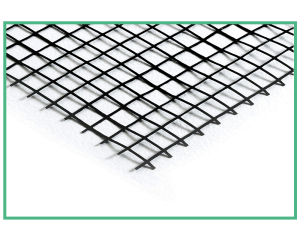
Another aspect to bear in mind is surface erosion of the soil: to counteract this, synthetic geomats are applied, also with a mulching function to encourage the growth of grass cover, or natural fibre bionets.
Also in this case, TeMa Geo Solutions offers a wide choice ranging from Ecovermat F Grass and Ecovernet FJ to the K-Mat range.
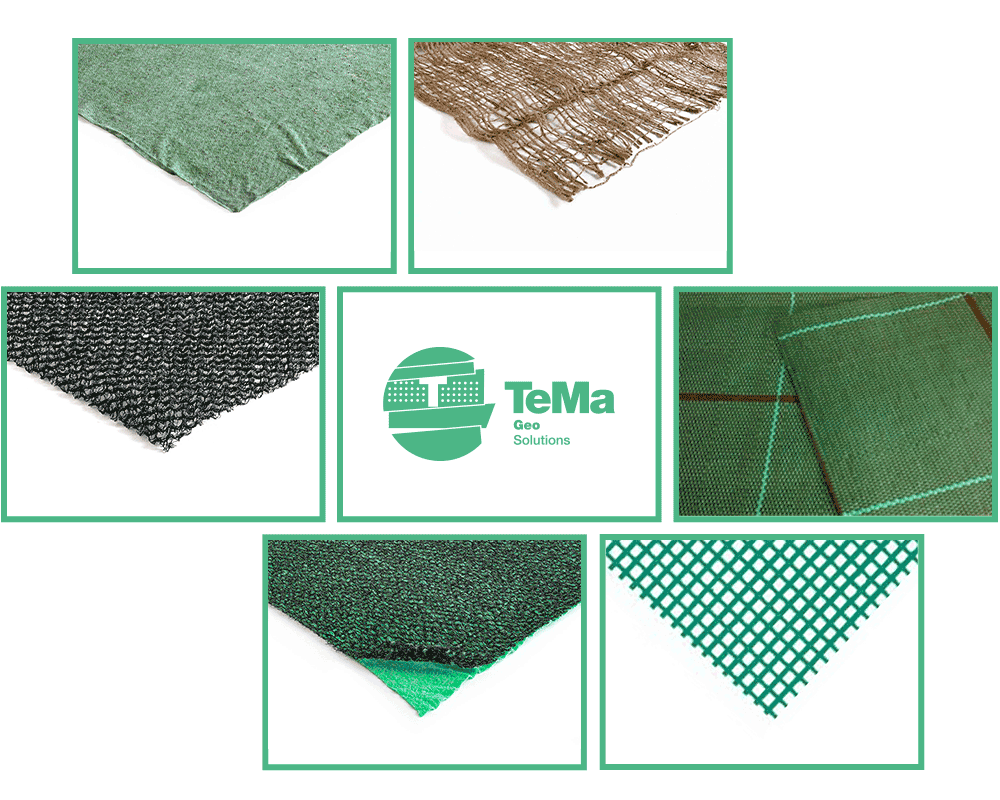
Why use a vegetation barrier as a protective noise barrier?
A vegetation barrier has an unquestionable ability to limit the spread of sound waves: some of them are absorbed, some reflected and some deflected. As a result, the amount of sound waves reaching the receiver is greatly reduced and noise can be dampened by several decibels.
The advantages of a reinforced earth sound-deadening barriera
Creating reinforced earth structures brings considerable advantages:
- it costs less because you can often use earth available on-site
- no special maintenance is required other than regular trimming.
- it helps the environment and integrates with it: the use of vegetation also reduces vehicle emissions by absorbing CO 2 and purifying the air.
- 1
- 2

